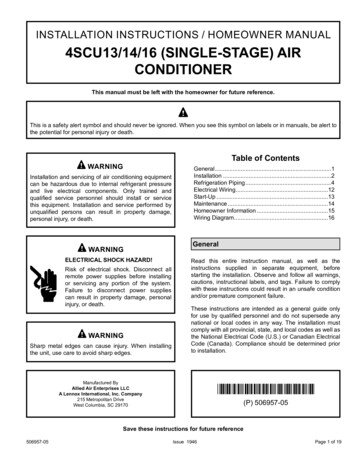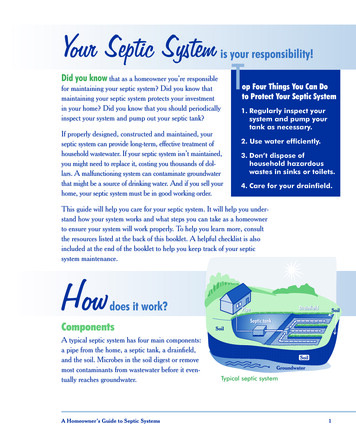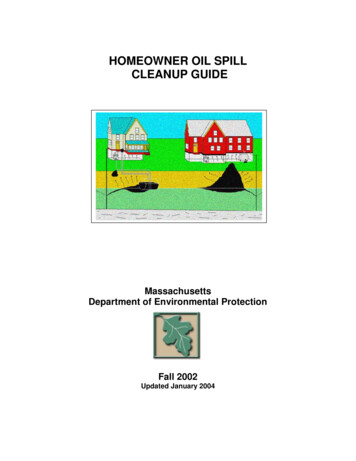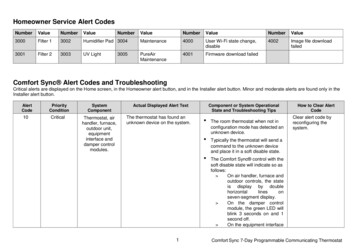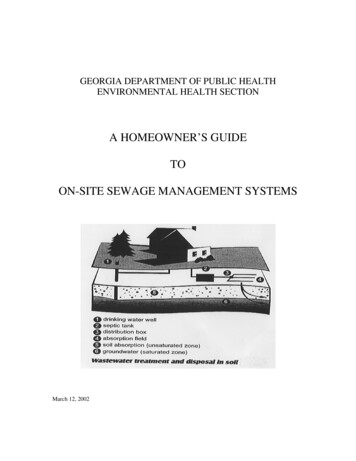
Transcription
GEORGIA DEPARTMENT OF PUBLIC HEALTHENVIRONMENTAL HEALTH SECTIONA HOMEOWNER’S GUIDETOON-SITE SEWAGE MANAGEMENT SYSTEMSMarch 12, 2002
WHAT IS AN ON-SITE SEWAGE MANAGEMENT SYSTEMAn on-site sewage management system is a wastewater treatment system designed to use the soil to treatthe wastewater generated by a home, business or other building intended for human occupancy orcongregation. These types of systems are utilized in areas where central public sewage treatment is notavailable. The system is “on-site” because the sewage treatment and disposal is accomplished entirely onyour property. One of the major differences between owning an on site system and a public sewer systemis that the on site system must be maintained by the homeowner.The most common on-site sewage management system is the septic tank system. The system typicallyconsists of two major components: a primary treatment tank and an absorption field. The most commontype of primary treatment tank is a septic tank. The septic tank may be made of concrete, fiberglass, orplastic. All septic tanks have inlet and outlet tees. Septic tanks installed prior to February 20, 2000 consistof a single compartment. Septic tanks installed after February 20, 2000 are required to have twocompartments and an effluent filter. All septic tanks approved for use with on site sewage managementsystems are reviewed and approved by the Georgia Department of Human Resources.The number of bedrooms determines the size of the septic tank serving a single family residence. Theminimum size septic tank approved for use in the State of Georgia is a 1000 gallon tank, which will serve a3 or 4 bedroom house. Homes with garbage disposals are required to increase the size of the septic tank by50%. The primary purpose of the septic tank is to separate the solids from the liquid in order to facilitatethe breakdown of the solids by microorganisms naturally present in the wastewater. The solids, known assludge, collect in the bottom of the tank. This sludge must be pumped out periodically in order for thesystem to operate properly.Keeping the solids out of the soil absorption field prevents soil clogging and helps insure the ability of thesoil to effectively treat the wastewater. An effluent filter on the outlet of the septic tank is used to protectthe absorption field from solids exiting the septic tank. As solids accumulate in the septic tank, the effluentfilter may become clogged. This is an indication that it is time to have the solids pumped out of the septictank and clean the filter.The wastewater effluent coming out of the septic tank may contain disease causing microorganisms andpollutants. The soil acts as a natural filter and treats the wastewater effluent through physical, biologicaland chemical processes. Harmful bacteria, viruses, and pollutants are treated as the wastewater effluentmoves down through the soil before it reaches the groundwater table. The absorption field must be locatedin an area of unsaturated soil in order to facilitate this process. For this reason, a soil analysis is required onall property served by an on site sewage management system.The typical septic tank system is a gravity flow system where the wastewater flows down into the system.The wastewater effluent is passed on to the absorption field through a connecting solid pipe. There arethree primary absorption field design methods: level field, distribution box and serial distribution. On leveltopography, the level field method may be utilized. Absorption lines are installed level and interconnectedto form a continuous absorption field. The distribution box method may be used on level or slopingtopography. The wastewater enters a distribution box where the flow is equally distributed to two or moreabsorption lines of equal length. On sloping topography, the serial distribution method may be used.When this method is used, level absorption lines shall run parallel with the ground contours. The solid linefrom the septic tank enters the uppermost absorption line. Adjacent absorption lines are successivelyconnected by means of overflow sewers to form an absorption field.In some instances, the wastewater effluent may need to be pumped up hill to an absorption field. Thewastewater effluent from the septic tank will enter a separate dosing tank. A pump approved forwastewater effluent is placed in the dosing tank in order to transport the wastewater effluent to theabsorption field. The dosing tank should have a reserve capacity equal to the peak daily water usage fromthe home. Peak daily water usage is based on 150 gallons per bedroom. For a three bedroom house thiswould be a reserve capacity of 450 gallons, and 600 gallons for a four bedroom house. In the event of a2
power outage or pump failure the storage capacity of the dosing tank will allow temporary use of home’son site sewage management system. An audible high water alarm is required in the dosing tank to notifythe homeowner in the event of a pump failure.The absorption field may be constructed of gravel or other approved aggregate, chamber, gravelless pipe,drip irrigation or other approved alternative product. The type of absorption field is usually determined bythe soil conditions present on the site. For single family residences, the number of bedrooms and the soilpercolation rate determines the size of the absorption field. A list of approved alternative absorption fieldproducts may be obtained from the Department. All on site sewage management systems are permitted andinspected by the local county health department for compliance with the Georgia Department of HumanResources Rules and Regulations for On Site Sewage Management Systems, Chapter 290-5-26.3
OPERATION AND MAINTENANCEWith proper use and maintenance your on site sewage management system will serve your family for manyyears. All homeowners should obtain a copy of the on site sewage management system inspection reportfrom the local county health department. The inspection report will show the type and location of the onsite sewage management system. Any maintenance or repair to an on site sewage management systemmust be performed by a septage removal and disposal company or septic tank contractor certified by theDepartment of Human Resources.Proper Use:Direct all wastewater from the home into the septic tank. This includes all sink, bath, shower, washingmachine, toilet and dishwasher wastewater. Any of these wastewaters can contain disease causingorganisms and pollutants. The department does allow separate black water and gray water systems forwater reuse. All gray water must be disposed of in an on site sewage management system. Practice water conservation to avoid overloading the on site sewage system. Repair dripping faucetsand leaking toilets. Run dishwashers when full. Do not do all your laundry in one day. Space out thewashing machine use over the week. Replace old fixtures with water saving fixtures. Do not direct water from gutter downspouts, sump pumps or subsurface drains into the septic tank.The on site sewage management system is designed based on an estimated daily water use. Excesswater directed into the septic tank will cause a hydraulic failure. Use commercial bathroom cleaners and anti-bacterial soaps in moderation. Treatment in the septictank depends on natural bacteria. The Department does not recommend the use of septic tankadditives. These products are not necessary for proper system operation. Do not plant trees or bushes on top of the absorption line. Root intrusion may damage and block theabsorption line. Landscape the site to allow surface water to drain off of the absorption field area. Divert roof drainsfrom the absorption field area. Standing water over the absorption field will cause soil saturation andpotential system failure. Do not park or drive over the septic tank or absorption field. This can damage the septic tank andabsorption field. Soil compaction can occur reducing the ability of the soil to absorb the wastewaterfrom the system. Do not pour grease, oil, paint or other chemical products down the drain. Do not put nonbiodegradable items such as cigarette butts, feminine hygiene products, condoms, disposable diapers orother similar solid waste into the septic tank.When to Pump the Septic TankA properly designed septic tank system will have a septic tank with sufficient volume to accumulate solidsfor several years. Over time the solids accumulate and begin to fill up the septic tank. If these solids arenot periodically pumped out, suspended solid particles may begin to flow into the absorption field. Thesesolids will eventually clog the absorption field and may require the installation of a new absorption field.Newer septic tank systems are required to have an effluent filter located on the outlet of the septic tank.The purpose of this filter is to protect the absorption field by trapping suspended solids. If the septic tank isnot pumped out periodically, the effluent filter may become clogged causing wastewater to back up into thehouse.4
A specific determination of when it’s time to pump a septic tank can be made by having the depth of thesolids and level of scum buildup checked periodically. New septic tanks have an access port over the inletand outlet tees to facilitate the cleaning of the effluent filter and pumping of the tank. Two factorsprimarily affect the pumping frequency required. The first factor is the holding capacity of the septic tank.The more people using a system, the faster the solids build up, and the more frequently the tank will haveto be pumped. A larger capacity system provides better treatment and requires less pumping. The standardthree or four bedroom house has a 1000 gallon septic tank.The second factor is the amount of solids in the wastewater. If you have a garbage disposal, you will haveto pump out your septic tank more frequently. The use of a garbage disposal may increase the amount ofsolids in a septic tank by as much as 50%. Pouring grease or other non-biodegradable types of solid wastedrown the drain will add to the accumulation of solids. Homes with garbage disposals are required toincrease the size of their septic tank by 50%. A three or four bedroom house with a garbage disposal isrequired to have a 1500 gallon septic tank.The recommended pumping frequency for pumping out septic tanks can be estimated based on assuming awastewater retention time of 24 hours and assuming that 50% of the solids are digested by bacterial actionin the tank. The following table can be used as a guide for average home water usage without a garbagedisposal.Estimated Septic Tank Pumping Frequency(year round residences)TankSize(gal)1000150020002500Household Size (Number of 0.7years1.3years2.3years2.6years
A certified septage removal and disposal contractor must pump the septic tank out. Access to the septictank shall be through the access ports in the tank or by removal of the tank lids. Holes should not be madeinto the septic tank. The contractor is required to completely remove the contents of the septic tank. Thecontractor should check the inlet and outlet tees for damage. Damaged inlet and outlet tees should bereplaced. The inlet and outlet tees direct the wastewater to the bottom of the tank and prevent solids fromexiting the tank to the absorption field. If an effluent filter is present, the filter shall be cleaned andreinstalled. The excavated soil removed to expose the access ports of the septic tank shall be replaced. Thecontractor is required to give the homeowner written documentation of the condition of the septic tank andthe work performed. Homeowners should keep all maintenance records. Many lending institutions requirean existing system evaluation for loan closings, which includes documentation of maintenance performed.The State Office of Environmental Health does not recommend the use of septic tank additives.Commercial septic tank additives do not eliminate the need for periodic pumping and may be harmful tothe absorption field. You should not need biological or chemical additives for successful restart orcontinuous operation of your septic tank system. You should not wash or disinfect the septic tank afterpumping.Signs of a Malfunctioning Septic Tank System1.2.3.Slow drains or sewage backing up into the house: The cause could be a blockage in the plumbing lineto the septic tank, blockage to inlet and outlet tees within the septic tank or a clogged filter if present.If the problem only occurs during rainy weather, the problem could be related to surface waterdrainage or water standing on top of the absorption field area. If the septic tank system is old, theabsorption line may be clogged. If the system has a pump, pump failure could be the cause.Surfacing of septic tank effluent on the ground surface: The cause may be related to a poor soilabsorption rate, soil clogging in the absorption line, or water usage. If the problem is noticeable onlyafter rainy weather, the problem could be related to surface water drainage or a high seasonalgroundwater table.Smell of sewage odor: The cause of sewage odors may be natural gases that occur in the septic tankthat are vented from the plumbing system through the roof of the house. Odors may be noticeable inthe area of the vent pipe. Odors near the septic tank could indicate a cracked inlet or outlet plumbingpipe. Odors in the absorption field area could indicate a surfacing of wastewater effluent.Any repair work performed on an on site sewage management system requires a repair permit from thecounty health department. The county environmental health specialist can assist homeowners with anevaluation of the system to determine repair options. A certified septic tank contractor should perform anyrepair work. A list of approved contractors can be obtained from the local county health department or theEnvironmental Health Section, Georgia Department of Human Resources at 404-657-6534.ADVANCED SEWAGE TREATMENT SYSTEMSNot all property in the State of Georgia is suitable for a typical septic tank system. In areas where the soilis not capable of treating domestic wastewater, an advanced sewage treatment system may be utilized aspart of an on site sewage management system. Advanced treatment systems facilitate treatment of thewastewater before application to the soil absorption field. Information on advanced treatment systemsapproved for use may be obtained from the local county health department or the Georgia Department ofHuman Resources, Environmental Health Section.Aerobic Treatment Units: Aerobic treatment units are stand alone advanced sewage treatment systems,providing wastewater treatment prior to disposal in the subsurface absorption field. Aerobic treatment units(ATUs) provide aerobic biodegradation or decomposition of wastewater constituents by bringing thewastewater into contact with air mechanically. ATUs come in different configurations and sizes, and6
incorporate a variety of approaches, including air pumps, air injectors, lift pumps and biological-contactsurfaces.Bio-Peat Systems: The typical bio-peat system consists of a septic tank, a dosing tank with effluent pump,pretreatment modules containing specialized biofibrous peat, and a soil absorption field. The septic tankwastewater effluent is pumped to and equally distributed through the biofilter modules. As the wastewatereffluent passes through the peat a combination of physical, chemical and biological treatment occurs. Thewastewater effluent exits the bottom of the modules into the absorption field.Information on maintaining advanced treatment systems should be obtained from the manufacturer. Insome instances a service contract is required.ReferencesGeorgia Department of Human Resources. 2001. “Manual for On Site Sewage ManagementSystems.”Environmental Health Section, Atlanta, Georgia.National Small Flows Clearinghouse, “The care and feeding of your septic tank system.” West VirginiaUniversity, Morgantown, West Virginia.National Small Flows Clearinghouse, “So now you own a septic system.” West Virginia University,Morgantown, West Virginia.U.S. Environmental Protection Agency, 1999. “Septic Tank – Soil Absorption Systems.” Office of WaterOperations, Washington, District of Columbia.7
ON SITE SEWAGE MANAGEMENT SYSTEMMAINTENANCE RECORDLocation Address:Subdivision Name and Lot/Block:DateContractor and Work PerformedObservations/Notes:8
3 power outage or pump failure the storage capacity of the dosing tank will allow temporary use of home's on site sewage management system. An audible high water alarm is required in the dosing tank to notify

